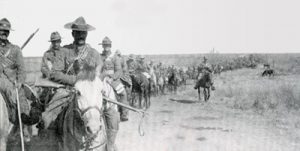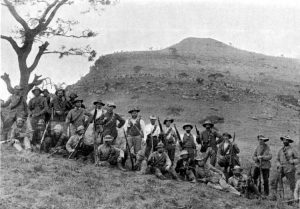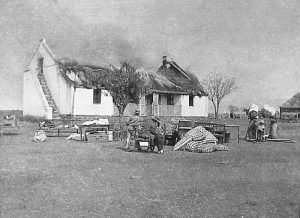Historical Lenses are a means of analyzing history in different, interesting ways. By using historical lenses, we can achieve a deeper understanding of historical events. In PLP, we have spent the last week focusing on 6 different historical lenses, presenting our findings on each lens to the class. The six historical lenses we studied included Historical Significance, Evidence and Interpretation, Continuity and Change, Cause and Consequence, Historical Perspective, and Ethical Judgment. By applying these six historical lenses to a specific event, we can achieve a greater understanding of it. Here is a video on each historical lens, described in detail.
Let’s address all six historical lenses into one historical event, and achieve a deep understanding of it. The historical event we will be studying is Canada’s involvement in The South African War (1899-1902), also known as The Boer War. This war marked the first time Canadian soldiers would ever dispatch to fight overseas.
In the year 1899, a conflict arose between Great Britain and two small republics in South Africa. Boers were Dutch descendants who settled in South Africa, and were not expected to put up a good fight against the immense power of Britain. Canadians had heard of this conflict, and pro-empire citizens urged their government to participate in the fighting. The war, they argued, pitted British freedom, justice, and civilization against Boer backwardness.
Canada was made up of many different backgrounds, prominently French-Canadians and English-Canadians. The English-Canadians strongly supported Britains cause in the conflict, while the French-Canadians and immigrants from other countries questioned the ethicalness of part-taking in a war on the other side of the world.

2nd Canadian Mounted Rifles riding through the veldt while chasing small bands of Boers in Transvaal, March 1902 (NAC PA-173029).
The Prime Minister of the time, Sir Wilfrid Laurier did not want to commit his government to the conflict, worried about national stability and political popularity. The public continued pressuring him, and thus he decided to deploy a battalion of volunteers to South Africa. Over the next three years, more than 7,000 Canadians, including 12 women nurses, served overseas. The boers lost many vital battles, but nonetheless inflicted noticeable damage to the Canadian and British forces. The conflict was brutal, as harsh conditions, disease, and the guerrilla-style warfare from the boers incited damage to Canadian forces.
Imperial forces attempted to deny the Boers the food, water and lodging afforded by sympathetic farmers. Britain’s grim strategy took the war to the civilian population. Canadian troops burned Boer houses and farms, and moved civilians to internment camps. In these filthy camps, an estimated 28,000 prisoners died of disease, most of them women, children, and black workers. Civilian deaths provoked outrage in Britain and in Canada. This harsh strategy eventually defeated the Boers. 267 Canadian troops were killed in this war, and their names are listed in the Book of Remembrance.
This conflict saw the first overseas deployment of Canadian troops, marking it to be of high historical significance. Canadian troops, in the first of many, and much greater conflicts to come in the 20th century, had distinguished themselves in South Africa. Their tenacity, stamina and initiative seemed especially suited to the Boers’ unorthodox guerrilla tactics. This was very notable of the soldiers, seeing the consequence of earned respect for Canadian troops. There is a large amount of evidence for this battle in the form of primary sources. Photographs document the Canadian soldiers in the rigid atmosphere of the battleground. The information is trustworthy, as it is supplied by reliable sources such as The Canadian Encyclopedia. This evidence can assist us in learning what the conditions of the battle were like, the tools used, and the severity of the conflict. When looking at where change happened, and where continuity was present, we can see that a change happened with Canadian citizens mindset. Those who might have supported the involvement of the war before deployment later changed their mindset once they learned the atrocities caused against civilians. The view on Canadian soldiers changed, as they were seen internationally as a powerful force. It fuelled a sense that Canada could stand apart from the British Empire, and it highlighted the French-English divide over Canada’s role in world affairs — two factors that would soon appear again in the First World War. Now we must asses the causes and consequences of this conflict. Britain’s pretext for war was the denial of political rights by the Boers to the growing population of foreigners. Canada became involved due to their loyalty to the Empire. Canada did not have a professional army at the time. The country was very divided on whether or not to partake in the conflict, giving the Prime Minister a tough decision on what to do. Eventually, under intense pressure, the government authorized the recruitment of a token force of 1,000 volunteer infantrymen. The consequence of this was Canada being seen as a force, strong and powerful force. The harsh tactics of the Boers caused Canadian and British forces to act intensely, sending civilians to terrible camps and burning their homes. The consequence of this was felt, as civilian deaths provoked outrage in Britain and in Canada. When analyzing this event using a historical perspective, it is clear to see that there was a divide in opinion of deploying Canadian troops. We can see how strongly the English-Canadians influenced the Prime Minister, causing him to deploy the soldiers. Finally, we must ask whether it was ethical to deploy the Canadian troops. This was not a fight in which it was necessary for their participation. Nonetheless, their participations proved themselves as an army, and the strength Canada had. Depending on which perspective you take, this event can be seen as ethical or non-ethical. The killing of civilians done by the Canadian soldiers was very unethical, and this emotion was felt back then as well.
By applying historical lenses to an event, we can attain a strong understanding of its effect on society, learn from it, and grow as a society. They are very important, as they allow us to open our minds, and see the past in different ways. By applying these six lenses to the Boer War, and Canada’s participation, we learn a great deal. We investigated the ethics of it, looked at it through a historical perspective, analyzed change and continuity, focused on the changes and consequences, and used evidence to interoperate the event. After learning about these six lenses, I challenge you to apply the six lenses to a historical event of your choice, and attain a deeper understanding of it.






